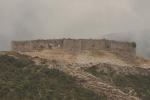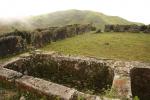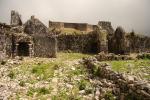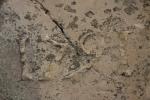Preserve Haitian History

A kind of neglect or ignorance among certain sectors of development, some may say all sectors, but mainly an emphasis and lack of resources for tourism, has left Haiti a place to be discovered, or rediscovered. And those of us fortunate enough to live here, with the will and interest to learn and search out all that Haiti has to offer, have the privilege of enjoying many of these finds completely alone without the distractions brought by a tourist attraction.

 Only a five-minute drive east of the plantation atop a hill on the same mountain range sits Fort Drouet. The leaders of the republic built 20 or so of these forts around the country to protect them against an anticipated return of the French after the successful revolution. Here between to jugged mountaintops you peer directly onto the island of La Gonave to the east. In every other direction, mountain range after rolling mountain range, deye mon gen mon, is all you see. The fort’s thick walls are as sound as they must have been in the 1800s and the gunner windows pointing in every possible direction display defensive strategies. From Google Earth, or an international flight north, the fort looks like an outline of a giant turtle. Inside there is a powder house completely untouched with vibrant red moss painting the exterior and a permanent dampness trapped inside. A bit lower than Fort Drouet on an opposing mound are the extensive ruins of what appear to be some sort of industrial activity, milling, livestock, roasting or all of the above may have been tended to here.
Only a five-minute drive east of the plantation atop a hill on the same mountain range sits Fort Drouet. The leaders of the republic built 20 or so of these forts around the country to protect them against an anticipated return of the French after the successful revolution. Here between to jugged mountaintops you peer directly onto the island of La Gonave to the east. In every other direction, mountain range after rolling mountain range, deye mon gen mon, is all you see. The fort’s thick walls are as sound as they must have been in the 1800s and the gunner windows pointing in every possible direction display defensive strategies. From Google Earth, or an international flight north, the fort looks like an outline of a giant turtle. Inside there is a powder house completely untouched with vibrant red moss painting the exterior and a permanent dampness trapped inside. A bit lower than Fort Drouet on an opposing mound are the extensive ruins of what appear to be some sort of industrial activity, milling, livestock, roasting or all of the above may have been tended to here.
 In between Dion and Fort Drouet are a few ruins with corner stones embossed with dates and names, 1791, F.P.T. LaSaline pictured here for example. This just off the newly graded government road which, questions what was here before the road and perhaps a sign that the neglect and ignorance for such important historic riches continues. But not only here, you can look out in a few directions on the mountain range and with a keen eye spot remnants of walls, structures, circles, jutting out among the now barren mountains but overgrown with the brush and green that thrive.
In between Dion and Fort Drouet are a few ruins with corner stones embossed with dates and names, 1791, F.P.T. LaSaline pictured here for example. This just off the newly graded government road which, questions what was here before the road and perhaps a sign that the neglect and ignorance for such important historic riches continues. But not only here, you can look out in a few directions on the mountain range and with a keen eye spot remnants of walls, structures, circles, jutting out among the now barren mountains but overgrown with the brush and green that thrive.
Though these are only ruins, their surroundings are barren and while arriving to the sights isn’t necessarily convenient, you truly get a sense of how grandiose, rich and prominent a role Haiti once was in the world. And how impossible life must have been for those whose unfortunate fate it was that brought them here to make it so powerful a place.
To view more photos of Fort Drouet or Plantation click here.
Add new comment